Hjalmar, Elsa, and my mother in Beijing!
The kids arrived with their grand-mother in good order today to Capital Airport in Beijing, and I was there to pick them up. We went in two taxis home, went out and had lunch, and then the travelers got to rest while I taught my last class before our National Day holiday (lasting eight days!).
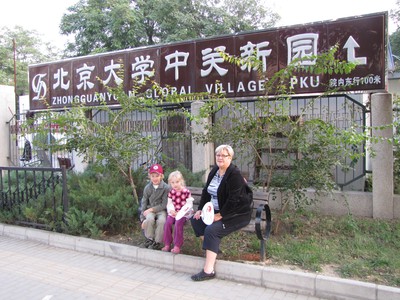
In the late afternoon, we walked to the university campus, where there was an international event. International students had set up booths for their own countries. We met some Swedish students, who had put up a Swedish booth (complete with portraits of the Crown Princess, Northern lights, and Drottningholms castle). I was curious about the North Korean booth, at a safe distance from South Korea!

Hjalmar and Elsa enjoyed the posters in the Swedish booth, to the degree that Hjalmar photographed them.

But what really was interesting was how fascinated people were by the children, perhaps especially Elsa. People are apparently not used to anyone that light-colored, and many, many came forward to tell her how beautiful she is (in Chinese and English!). Many, many wanted to photograph both of the kids as well. But they are, of course, very beautiful.
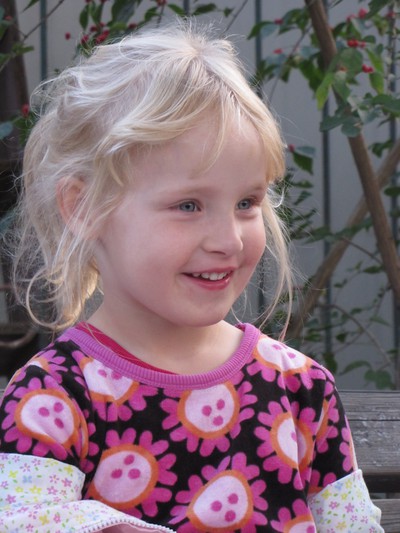
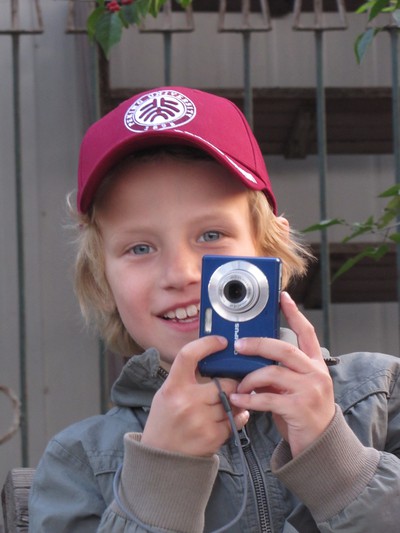
I lent Hjalmar my small camera, and he enjoyed taking a lot of photos.
In the evening, we went to a very good restaurant with Hanzhou food (where my friend, Professor Peng brought me to dinner a few weeks ago). We had a very good meal; the pork and the noodle soup attracted us especially. The same thing happened here: the waitresses (and an occasional waiter) really liked Elsa. At one point we counted nine waitresses who looked at her. Most of them came forward to tell us how beautiful she is. One of them took a special liking to Elsa, spoke a lot with her (this waitress spoke no English at all).
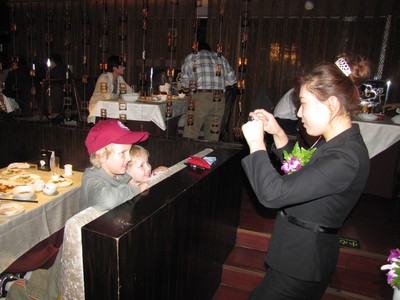
There are different ranks of waitresses at the restaurant, and some of them wore tiaras. She lent it to Elsa, who was absolutely delighted.
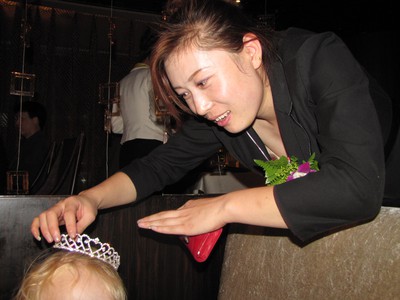
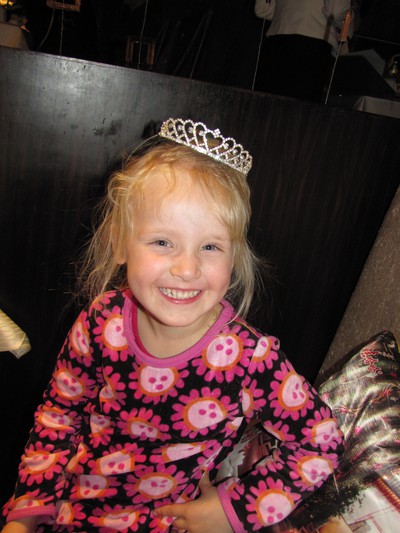

In Hjalmar's camera I found this picture of us dining.

And a very good portrait of his grand-mother.
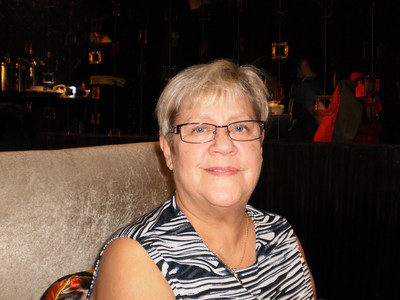
Hjalmar is a very good photographer.
He was also interested in the décor of the restaurant. Especially two large statues.
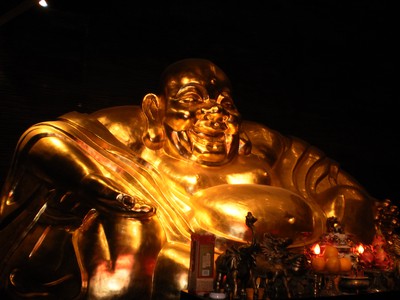


In the late afternoon, we walked to the university campus, where there was an international event. International students had set up booths for their own countries. We met some Swedish students, who had put up a Swedish booth (complete with portraits of the Crown Princess, Northern lights, and Drottningholms castle). I was curious about the North Korean booth, at a safe distance from South Korea!

Hjalmar and Elsa enjoyed the posters in the Swedish booth, to the degree that Hjalmar photographed them.

But what really was interesting was how fascinated people were by the children, perhaps especially Elsa. People are apparently not used to anyone that light-colored, and many, many came forward to tell her how beautiful she is (in Chinese and English!). Many, many wanted to photograph both of the kids as well. But they are, of course, very beautiful.


I lent Hjalmar my small camera, and he enjoyed taking a lot of photos.
In the evening, we went to a very good restaurant with Hanzhou food (where my friend, Professor Peng brought me to dinner a few weeks ago). We had a very good meal; the pork and the noodle soup attracted us especially. The same thing happened here: the waitresses (and an occasional waiter) really liked Elsa. At one point we counted nine waitresses who looked at her. Most of them came forward to tell us how beautiful she is. One of them took a special liking to Elsa, spoke a lot with her (this waitress spoke no English at all).

There are different ranks of waitresses at the restaurant, and some of them wore tiaras. She lent it to Elsa, who was absolutely delighted.



In Hjalmar's camera I found this picture of us dining.

And a very good portrait of his grand-mother.

Hjalmar is a very good photographer.
He was also interested in the décor of the restaurant. Especially two large statues.


Work in the University library
Today I worked both before and after my class (10.10-12.00) in the University library of PKU. It is housed in a beautiful building at the center of campus. As is appropriate, since the library is one of the most central institutions in a university.
It is a great library. But it has some oddities, such as strange opening hours: Closed all of the National Day holiday, which is coming up on Friday and one week afterwards, strange lunch closings of some departments for an hour and a half every day. One would think with PKU's ambition to raise in the rankings of the world's universities that the powers that be would be a little more concerned about getting the library to operate as a first-rate modern library.

The collection of books in medieval history is a respectable one, at least as long as one stays with good books in English (and Chinese, I suppose, but I have very little competence to pass judgment on that). There is a selection of good books in other languages as well, but much fewer than English. Here is a glimpse of some medieval shelves. One recognizes (in burgundy) four very well used volumes of the New Cambridge Medieval History.

After my class, I had lunch with one of my students in the student dining hall, and she took this picture of me. The dining hall serves great food at amazing prices. And everything is made from skratch, not from prefabricated stuff as at Yale.

It is a great library. But it has some oddities, such as strange opening hours: Closed all of the National Day holiday, which is coming up on Friday and one week afterwards, strange lunch closings of some departments for an hour and a half every day. One would think with PKU's ambition to raise in the rankings of the world's universities that the powers that be would be a little more concerned about getting the library to operate as a first-rate modern library.

The collection of books in medieval history is a respectable one, at least as long as one stays with good books in English (and Chinese, I suppose, but I have very little competence to pass judgment on that). There is a selection of good books in other languages as well, but much fewer than English. Here is a glimpse of some medieval shelves. One recognizes (in burgundy) four very well used volumes of the New Cambridge Medieval History.

After my class, I had lunch with one of my students in the student dining hall, and she took this picture of me. The dining hall serves great food at amazing prices. And everything is made from skratch, not from prefabricated stuff as at Yale.

Excursion to Beijing Center for Chinese Studies
Friday is excursion day in the Yale-PKU program. Ningping organizes all kinds of pleasant and instructive excursions to various places around Beijing. Today we were meant to go to two libraries, the Beijing Center for Chinese Studies and the Chinese National Library. Both essential places for anyone who wants to study China seriously, or to study seriously in China. So it was disappointing that only three students (our of seven) indicated that they were interested in going. Even more disappointing when Ningping was waiting on the subway platform (our usual meeting spot) and the only one who actually came was I. It is rather pathetic, in the first place, that they are not more interested in serious study, but it is almost unforgiveably rude first to say that you will come and then not come without leaving any clear message to that effect. Something that I believe is all too common in the present generation of students, having been brought up by curling parents. This is rude towards the administrators of the program who go to great efforts to organize useful tours. (In all fairness, I should point out that one of the students, poor thing, was sick and had told us ahead of time.)
In any case, Ningping wanted to go anyway, with only she and I. We had a good time and we learnt stuff that one would have thought should be valuable to students. A very nice employee showed us around the Beijing Center, which aims (and apparently succeeds rather well) at collecting all literature about China in English (why only English? Valuable things are published also in other languages.) They also have a remarkable collection of rare books (in every language) with publications about China since the sixteenth century, plus old maps and old artefacts. A very nice place to visit. I saw a lot of books I know, and it was a good guided tour. If I ever would make reality of my old dream to do research on China, this would be the place to do it.
Afterwards, Ningping and I went to Metro, where I picked up my shopping card (preprinted with my name in Chinese) and also some muesli and wine. We had a great lunch, featuring a delicious cold leg of lamb, Mongol style.
Here I am at the Beijing Center next to a replica of a general from the terracotta warriors in Xian. The replica was made by the museum, so it is very good quality.

In any case, Ningping wanted to go anyway, with only she and I. We had a good time and we learnt stuff that one would have thought should be valuable to students. A very nice employee showed us around the Beijing Center, which aims (and apparently succeeds rather well) at collecting all literature about China in English (why only English? Valuable things are published also in other languages.) They also have a remarkable collection of rare books (in every language) with publications about China since the sixteenth century, plus old maps and old artefacts. A very nice place to visit. I saw a lot of books I know, and it was a good guided tour. If I ever would make reality of my old dream to do research on China, this would be the place to do it.
Afterwards, Ningping and I went to Metro, where I picked up my shopping card (preprinted with my name in Chinese) and also some muesli and wine. We had a great lunch, featuring a delicious cold leg of lamb, Mongol style.
Here I am at the Beijing Center next to a replica of a general from the terracotta warriors in Xian. The replica was made by the museum, so it is very good quality.

Pleasant midday break at Weiminghu
I went to the student dining hall early today to have lunch. Since all students have their lunch break from 12 to 1, the place is enormously crowded between 12 and 12.20. When I came at 11.30, there wasn't even a line, so I could peacefully decide which course I wanted. A nice combo of chicken thigh, green beans, and rice för 7 RMB. That is about 1 dollar, and it was very good. Better value for money than anything you could get in New Haven, obviously, and not to mention Sweden.
Afterwards I went to the bursar's office to fill up my meal card with money. I had prepared a sentence to say, but as so often in China, there is no unnecessary small talk, or any talk at all. Simply a line of students with their cards and money in the hands. At the front of the line, one gives the money to the cashier, puts the card into a machine, takes it out and walks away. Without a single word being uttered by anyone.
Afterwards, I walked down to the lake that is in the middle of the PKU campus. I had luck, for two persons got up from a bench by the water just before I arrived, so I got a seat. I had printed out pages from Alcuins letters from the Monumenta Germaniae Historica website, so I sat there in the very pleasant shade, by the water reading Alcuin in telling the king of Northumbria that the reason for the Vikings' sudden arrival probably was the poor moral state of people in his kingdom, so the king should get them to improve and start with himself. All while I was sipping of a cup of coffee. (Yes, one of my Chinese students on Monday pointed out an American-style café called Paradiso, close to the university library, so now I go there and get a small cup of coffee for 5 RMB when I feel the urge). That was just about perfect, especially since I had some Carrefour dark chocolate to nibble on.
This photo is taken from the bench, so the view is exactly the one I had while reading.
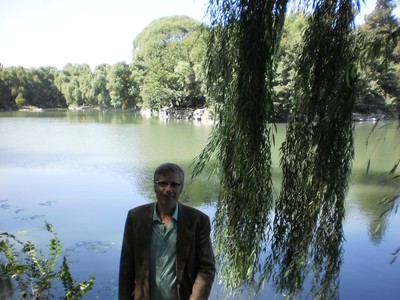
Afterwards I went to the bursar's office to fill up my meal card with money. I had prepared a sentence to say, but as so often in China, there is no unnecessary small talk, or any talk at all. Simply a line of students with their cards and money in the hands. At the front of the line, one gives the money to the cashier, puts the card into a machine, takes it out and walks away. Without a single word being uttered by anyone.
Afterwards, I walked down to the lake that is in the middle of the PKU campus. I had luck, for two persons got up from a bench by the water just before I arrived, so I got a seat. I had printed out pages from Alcuins letters from the Monumenta Germaniae Historica website, so I sat there in the very pleasant shade, by the water reading Alcuin in telling the king of Northumbria that the reason for the Vikings' sudden arrival probably was the poor moral state of people in his kingdom, so the king should get them to improve and start with himself. All while I was sipping of a cup of coffee. (Yes, one of my Chinese students on Monday pointed out an American-style café called Paradiso, close to the university library, so now I go there and get a small cup of coffee for 5 RMB when I feel the urge). That was just about perfect, especially since I had some Carrefour dark chocolate to nibble on.
This photo is taken from the bench, so the view is exactly the one I had while reading.

Hjalmar och Elsa har fått kinesiska namn
I dag har jag gett mina barn kinesiska namn. Såhär kommer de att heta. Först, Hjalmar:
文雅乐 Wen Ya Le. Ya betyder "elegant" och Le betyder "glad".
Och såhär heter Elsa:
文恩飒 Wen En Sa. En betyder "graciös" och Sa betyder "modig".
Wen betyder, förstås, "litteratur, kultur."
Jag tycker namnen passar bra på dem. Hoppas de tycker om dem.
Mamma heter förstås sedan tidigare
文爱娃 Wén Aì Wá. Ai betyder "älskad" och Wa betyder "docka".
文雅乐 Wen Ya Le. Ya betyder "elegant" och Le betyder "glad".
Och såhär heter Elsa:
文恩飒 Wen En Sa. En betyder "graciös" och Sa betyder "modig".
Wen betyder, förstås, "litteratur, kultur."
Jag tycker namnen passar bra på dem. Hoppas de tycker om dem.
Mamma heter förstås sedan tidigare
文爱娃 Wén Aì Wá. Ai betyder "älskad" och Wa betyder "docka".
Opening ceremony for Yale in Beijing
Here is the official group photo of Yale in Beijing. It includes professors and language teachers teaching in the program, the Yale students, their Yuanpei roommates, administrators in the Program and in the International office of PKU.
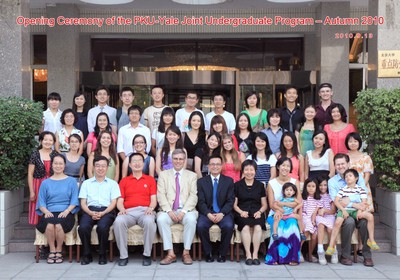

Moon cakes
Today is the mid-autumn festival, the day for eating moon cakes. This is what they look like. I discovered that this one actually has text on it, and I think it says mid-autumn 中秋. The cake has a filling, which is made from different kinds of sweet bean paste.
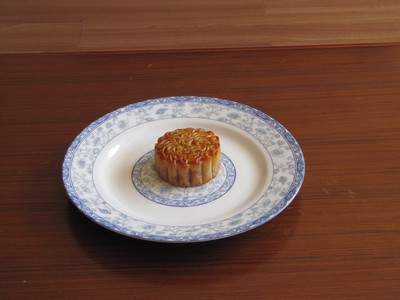
Here is the package in which kind Yuanpei college gave me eight moon cakes. Really too many to eat quickly, especially since I got six more from the International office at PKU yesterday.
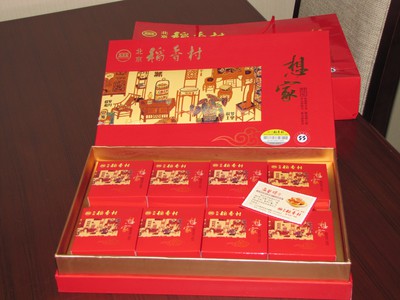

Here is the package in which kind Yuanpei college gave me eight moon cakes. Really too many to eat quickly, especially since I got six more from the International office at PKU yesterday.

Trip to the expat ghetto
A couple of weeks ago, I took the subway to the eastern side of town, where a lot of the expats (foreigners living in Beijing) live, and where there thus are a lot of things that cater to foreigners. Here are some of the things I saw.


This very nice river or canal looked very pretty. Beijing was founded on a couple of small rivers. The city very early ono used up all the water, so there is a lack of water in Beijing, but the government has built enormous aqueducts that lead water from great rivers down south to Beijing. This thing that look like a river must be dammed or something, since it does have so much water.
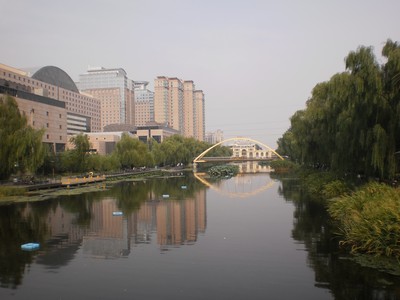


This very nice river or canal looked very pretty. Beijing was founded on a couple of small rivers. The city very early ono used up all the water, so there is a lack of water in Beijing, but the government has built enormous aqueducts that lead water from great rivers down south to Beijing. This thing that look like a river must be dammed or something, since it does have so much water.

Excursion for foreign experts
Wednesday 15 September is a university holiday, for it is the Mid-Autumn Festival. No teaching! (I wish Yale celebrated a mid-autumn festival!) Traditional Chinese festivals follow a lunar calendar, so this means that it will be full moon tomorrow.
To celebrate, the International Office at Peking University invited all foreigners who are teaching at PKU this semester to a wonderful dinner in the New Summer Palace (which is not new, but over a hundred years old). It is a huge park in which the last emperors of China had the palace they lived in during the summer. In the middle of the park is a large lake. There are very pleasant walkways among trees and green areas. Small streams and beautiful bridges.
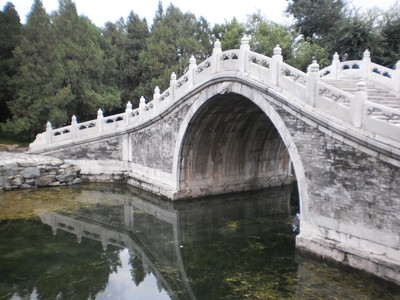
In the lake is the famous marble boat of Dowager Empress Cixi. It is a boat built out of marble! At the end of the nineteenth century China had money to produce a modern navy, which it needed since it was repeatedly defeated by western powers and Japan. Cixi thought the money was better spent building a new Summer palace (after western powers had destroyed the old one as punishment for China) and to build this very expensive marble boat.
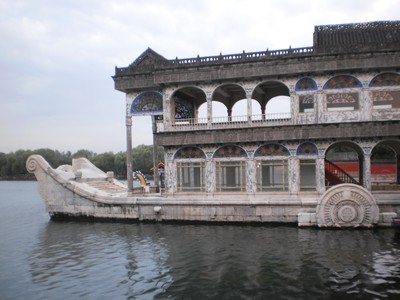
We walked through the park, passed the boat and got to the restaurant, where we were served a splendidly nice meal by servers dressed in traditional dress. The food was very good.

There was also a performance by members of the Peking University Orchestra for traditional instruments. The music was very enjoyable, and the players were very skilled.

After dinner it was time for us to get to ride a boat in the lake, to admire the full moon and the sights in the park. It was a gorgeous evening. We did not get to ride the marble boat, but we started out not far from it.

While we sailed, the players entertained with solo pieces.
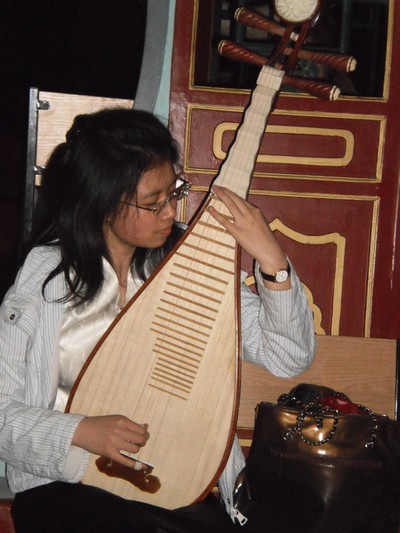
I met a lot of interesting people and talked all evening with them. An Israeli professor of neolithic archeology who now works at Harvard but excavates in China, a former president of the German university of Eichstätt (who knows someone I know from Yale), a doctoral student from the École Normale Supérieur in Paris, a professor of literature from Freie Universität Berlin, a UC San Diego professor of modern Chinese history and others. We had a lot of fun and they were very nice people. Most of them live in the same apartment complex as I, so now we are going to have dinners together.
At the end of the evening, we got a package of very fine mooncakes (the sweet, largeish, filled cookies that the Chinese eat for this holiday). I am eating one right now.
Here I am outside our restaurant.

To celebrate, the International Office at Peking University invited all foreigners who are teaching at PKU this semester to a wonderful dinner in the New Summer Palace (which is not new, but over a hundred years old). It is a huge park in which the last emperors of China had the palace they lived in during the summer. In the middle of the park is a large lake. There are very pleasant walkways among trees and green areas. Small streams and beautiful bridges.

In the lake is the famous marble boat of Dowager Empress Cixi. It is a boat built out of marble! At the end of the nineteenth century China had money to produce a modern navy, which it needed since it was repeatedly defeated by western powers and Japan. Cixi thought the money was better spent building a new Summer palace (after western powers had destroyed the old one as punishment for China) and to build this very expensive marble boat.

We walked through the park, passed the boat and got to the restaurant, where we were served a splendidly nice meal by servers dressed in traditional dress. The food was very good.

There was also a performance by members of the Peking University Orchestra for traditional instruments. The music was very enjoyable, and the players were very skilled.

After dinner it was time for us to get to ride a boat in the lake, to admire the full moon and the sights in the park. It was a gorgeous evening. We did not get to ride the marble boat, but we started out not far from it.

While we sailed, the players entertained with solo pieces.

I met a lot of interesting people and talked all evening with them. An Israeli professor of neolithic archeology who now works at Harvard but excavates in China, a former president of the German university of Eichstätt (who knows someone I know from Yale), a doctoral student from the École Normale Supérieur in Paris, a professor of literature from Freie Universität Berlin, a UC San Diego professor of modern Chinese history and others. We had a lot of fun and they were very nice people. Most of them live in the same apartment complex as I, so now we are going to have dinners together.
At the end of the evening, we got a package of very fine mooncakes (the sweet, largeish, filled cookies that the Chinese eat for this holiday). I am eating one right now.
Here I am outside our restaurant.

Mao in sandstorm
The largest statue of Mao Zedong in the world is in Kashgar. I suppose the great distance from Beijing makes a larger statue necessary.
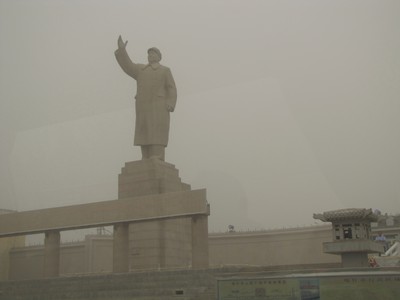

Kashgar livestock market II
More pictures from the livestock market in Kashgar.

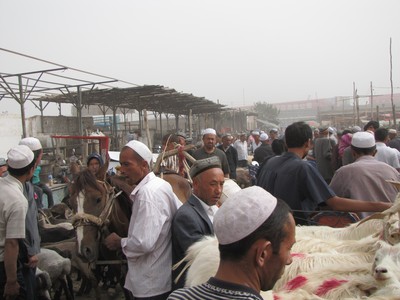
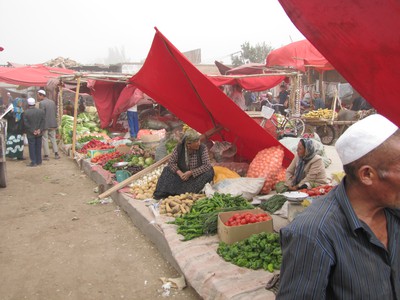
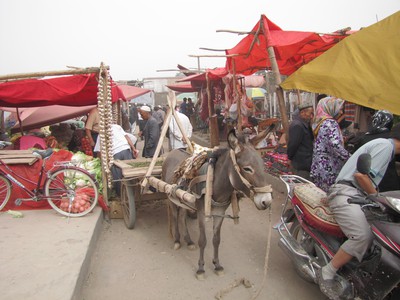
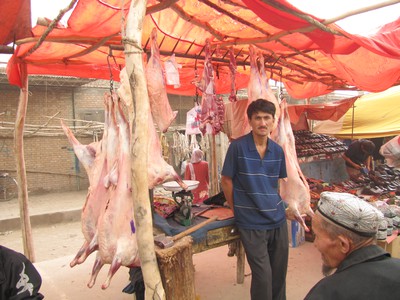







Chilly in Beijing
Fall started yesterday afternoon. It began to rain, and since I did not have my umbrella with me, I got rather wet on the way back form the office. No problem, I changed as soon as I got home. Today (17 September) the rain has continued, but very lightly. It is chilly, about 15 degrees Celsius. I think it is rather nice both with a little cooler temperatures (it was 32 on Monday!) and with a little humidity (Beijing is a very dry place).'
By the way, yesterday I took up my Chinese lessons again. I have a new, very good tutor.
By the way, yesterday I took up my Chinese lessons again. I have a new, very good tutor.
Livestock market in Kashgar
On Sunday 5 September, we visited the famous livestock market in Kashgar. That was really something to see! Amazing.
On the way there, we saw a lot of farmers bringing what they wanted to sell to the market.
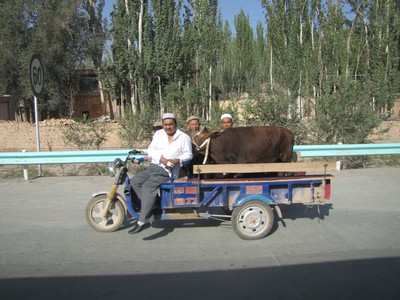


The market itself was divided into sections for different kinds of animals. First came the sheep, who all got to meet a very skilled barber.

Afterwards they were all very elegant.


Goats were also for sale.

As were donkeys, who really made a lot of noise in the way one reads about in children's books.


In the innermost part of the market was the horse market. A lot of things were happening here. I stayed for quite some time to look, while I was thinking of my great grand-father Alrik Johansson, who was a horse trader. I bet that horse markets in Sweden did not look that different in the 1910s from how this one looks.
I guess that this is a seller who is showing his horse to interested onlookers.
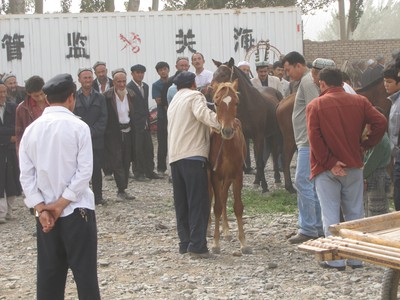
Rather often a guy was riding a horse. I never figured out whether these were sellers demonstrating the abilities of their horses, or buyers who took them for a trial run. They rode fast at any rate. Some of the horses seemed almost untamed. This guy managed well without a saddle.
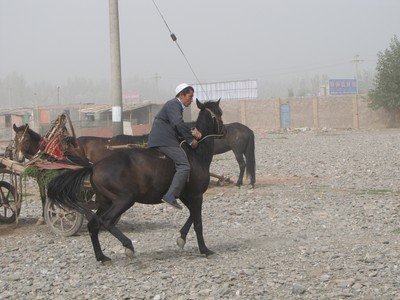
Others were demonstrating the speed of the horses by getting them to run around in this way. This is when I stayed close to a cart in order not to get in the way.
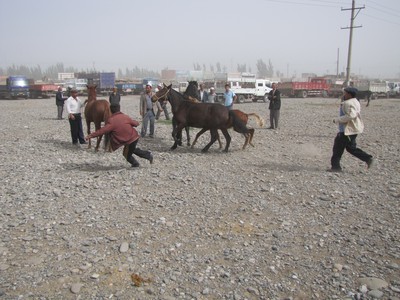
Towards the wall stood groups of elders, who followed everything very attentively. Don't they look as if they are thinking that the horses were better back in the fifties? Not too impressed.

I think this is the handshake that sealed the deal. They were shaking hands for a very long time, and it really looked like one had bought a horse from the other.
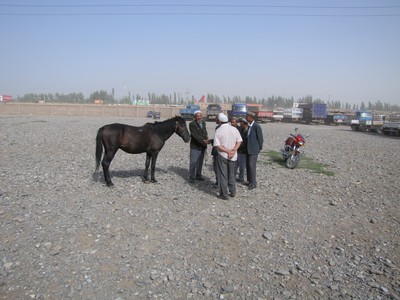
I have more pictures from the Livestock market, but I'll break off here. Notice how nice and blue the sky is in that last photo. That was taken perhaps half an hour before the photo of the old men and the photo of the man riding, in which the distance is rather hazy. The sandstorm that stranded us in Kashgar started while we were at the Livestock market, and I think it started between those two photos. And since I am on the subject, this is what the sand storm looked like. It is in the middle of the afternoon, not at night.
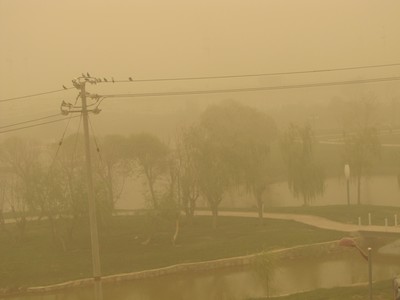
On the way there, we saw a lot of farmers bringing what they wanted to sell to the market.



The market itself was divided into sections for different kinds of animals. First came the sheep, who all got to meet a very skilled barber.

Afterwards they were all very elegant.


Goats were also for sale.

As were donkeys, who really made a lot of noise in the way one reads about in children's books.


In the innermost part of the market was the horse market. A lot of things were happening here. I stayed for quite some time to look, while I was thinking of my great grand-father Alrik Johansson, who was a horse trader. I bet that horse markets in Sweden did not look that different in the 1910s from how this one looks.
I guess that this is a seller who is showing his horse to interested onlookers.

Rather often a guy was riding a horse. I never figured out whether these were sellers demonstrating the abilities of their horses, or buyers who took them for a trial run. They rode fast at any rate. Some of the horses seemed almost untamed. This guy managed well without a saddle.

Others were demonstrating the speed of the horses by getting them to run around in this way. This is when I stayed close to a cart in order not to get in the way.

Towards the wall stood groups of elders, who followed everything very attentively. Don't they look as if they are thinking that the horses were better back in the fifties? Not too impressed.

I think this is the handshake that sealed the deal. They were shaking hands for a very long time, and it really looked like one had bought a horse from the other.

I have more pictures from the Livestock market, but I'll break off here. Notice how nice and blue the sky is in that last photo. That was taken perhaps half an hour before the photo of the old men and the photo of the man riding, in which the distance is rather hazy. The sandstorm that stranded us in Kashgar started while we were at the Livestock market, and I think it started between those two photos. And since I am on the subject, this is what the sand storm looked like. It is in the middle of the afternoon, not at night.

The great mosque in Ürümqi
The great mosque next to the bazar in Ürümqi was an impressive building.
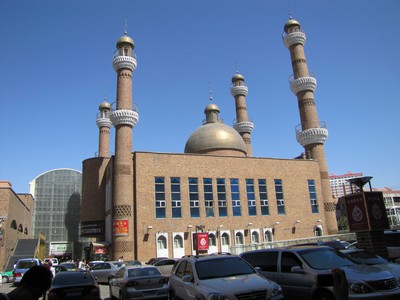
A very tall minaret.

With interesting reliefs.


A very tall minaret.

With interesting reliefs.

Jag idag 15 september
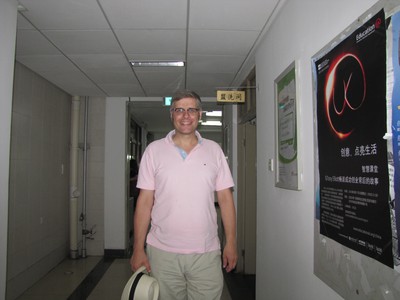
Hotel Seman in Kashgar - former Russian consulate
In Kashgar, we stayed at a very pleasant hotel called Seman. It was partially housed in the building that was built for hte Russian consulate in the nineteenth century. The interior was very nice. We got to stay there an extra night (but in new rooms) because of the sandstorm that prevented our departure.
The consulate has some interesting history. The great Finnish statesman Carl Gustaf Mannerheim, who would go on to become both the Commander in Chief of the Finnish armed forces in World War II, Marshal and President of Finland, stayed here in 1906 at the beginning of his trip through China, where he spied on military instalments. As a Finlander, Mannerheim was a subject of the czar and he was an officer in the Russian cavalry. He pretended to be an ethnographic collector and joined the expedition of the great French sinologist Paul Pelliot. He had a falling-out with Pelliot early on, so he did most of his trip on his own, spying out Chinese military installations in preparation for a possible Russian invasion of western China.



The consulate has some interesting history. The great Finnish statesman Carl Gustaf Mannerheim, who would go on to become both the Commander in Chief of the Finnish armed forces in World War II, Marshal and President of Finland, stayed here in 1906 at the beginning of his trip through China, where he spied on military instalments. As a Finlander, Mannerheim was a subject of the czar and he was an officer in the Russian cavalry. He pretended to be an ethnographic collector and joined the expedition of the great French sinologist Paul Pelliot. He had a falling-out with Pelliot early on, so he did most of his trip on his own, spying out Chinese military installations in preparation for a possible Russian invasion of western China.



Turpan karez water system
Turpan is an oasis in the Taklamakan desert (the second largest desert in the world after the Sahara). It is a large oasis which is famous for growing excellent grapes and melons. It is thanks to a clever irrigation system that the oasis has become so large.
The system consists of many underground canals that catch the ground water and leads it to the oasis. The canals connect dug wells. It all works thanks to the geography of the area. Look at the picture below, which shows a model of how it works. The Tianshan (Heavenly mountains) away in the picture are tall and snowcovered year-round. A lot of water comes from them. Some of this water becomes ground water, which collect north of the next, lower mountain range, the Flaming mountains. The area between the two mountain ranges becomes an underground water reservoir. When the ground water makes it over the Flaming mountain range it is collected in wells and then led to Turpan in underground canals. The canals have to be underground, because Turpan is so hot that the water would evaporate if it were on the surface. (When we arrived in the late afternoon, the temperature was 38, but it had been hotter earlier in the day, and this was in early September).
The system is a thousand years old or more!
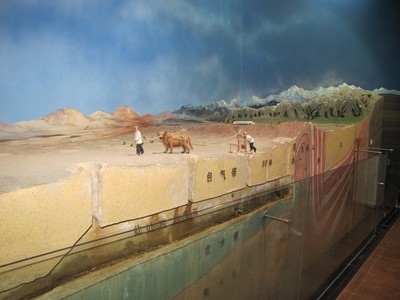
The representation of Turpan in the model. On the right side, one can see how an underground canal comes out on the surface to provide water for the oasis. Turpan is a deep valley, the second lowest point in the world after the shores of the Dead Sea, and well below sea level.

In the museum, one could also go down underground to see a real karez, and here it is.


An amazing testimony to human ingenuity.
The system consists of many underground canals that catch the ground water and leads it to the oasis. The canals connect dug wells. It all works thanks to the geography of the area. Look at the picture below, which shows a model of how it works. The Tianshan (Heavenly mountains) away in the picture are tall and snowcovered year-round. A lot of water comes from them. Some of this water becomes ground water, which collect north of the next, lower mountain range, the Flaming mountains. The area between the two mountain ranges becomes an underground water reservoir. When the ground water makes it over the Flaming mountain range it is collected in wells and then led to Turpan in underground canals. The canals have to be underground, because Turpan is so hot that the water would evaporate if it were on the surface. (When we arrived in the late afternoon, the temperature was 38, but it had been hotter earlier in the day, and this was in early September).
The system is a thousand years old or more!

The representation of Turpan in the model. On the right side, one can see how an underground canal comes out on the surface to provide water for the oasis. Turpan is a deep valley, the second lowest point in the world after the shores of the Dead Sea, and well below sea level.

In the museum, one could also go down underground to see a real karez, and here it is.


An amazing testimony to human ingenuity.
Numismatic museum, Beijing
Last Friday we also visited the Numismatic museum in Beijing, housed in a beautiful old bank building. There was in interesting exhibition of Chinese currency through the ages, including some really old paper money.
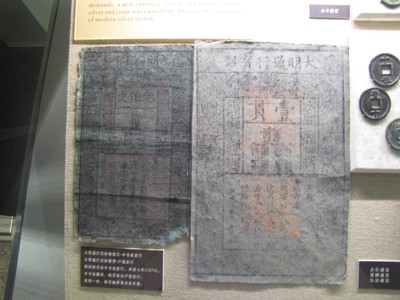
A lot of space was devoted to the efforts of the various Communist groups to issue money during the Chinese civil war. I take it that the Communists were so divided geographically that each group had to issue its own money. A few of the Chinese "soviets" issued bills with the countance of Lenin.
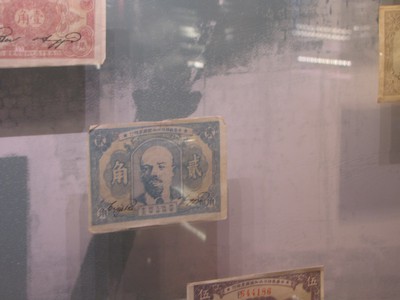
No explication in any language I can read here, but I take it this is a lithographic stone with which the bills were printed. I have never seen such a stone before.
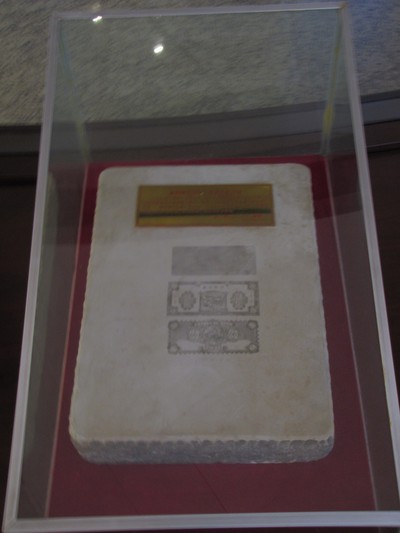
The exhibition was interesting (I did, for example, get to see those "strings of cash" that they constantly talk about in Dream of the Red Mansions). It was funny to compare this museum to the numismatic museum in Stockholm (Kungliga Myntkabinettet), which I visted in July. Both museums very strongly emphasized the currency of their own country, but the Stockholm one also had some international exhibits. Among those I remember seeing both bills issued in the Western concessons in China and even emergency money issued in the legation quarter in Beijing during their siege in the Boxer rebellion. This is part of China's monetary history, but I suppose it is not shown in China, for ideological reasons. On the other hand, I do not remember in Stockholm seeing any money issued by the Chinese communists before 1949.
Sorry for the quality of the images. It is hard to photograph through glas monters.

A lot of space was devoted to the efforts of the various Communist groups to issue money during the Chinese civil war. I take it that the Communists were so divided geographically that each group had to issue its own money. A few of the Chinese "soviets" issued bills with the countance of Lenin.

No explication in any language I can read here, but I take it this is a lithographic stone with which the bills were printed. I have never seen such a stone before.

The exhibition was interesting (I did, for example, get to see those "strings of cash" that they constantly talk about in Dream of the Red Mansions). It was funny to compare this museum to the numismatic museum in Stockholm (Kungliga Myntkabinettet), which I visted in July. Both museums very strongly emphasized the currency of their own country, but the Stockholm one also had some international exhibits. Among those I remember seeing both bills issued in the Western concessons in China and even emergency money issued in the legation quarter in Beijing during their siege in the Boxer rebellion. This is part of China's monetary history, but I suppose it is not shown in China, for ideological reasons. On the other hand, I do not remember in Stockholm seeing any money issued by the Chinese communists before 1949.
Sorry for the quality of the images. It is hard to photograph through glas monters.
The Emin Mosque in Turpan
The famous Emin Mosque in Turpan was built in the second half of the eighteenth century (1777-1778, according to Wikipedia). The minaret is 44 meters high and is the tallest minaret in China. All of it is built of sun-dried mud bricks. Such bricks do not withstand water, so if there would be a real downpour with rain, the mosque would be destroyed. In other words, Turpan has not had a real downpour since at least the late eighteenth century!

The mosque is now a government-run museum, even if it is used for Friday prayers, so we could go in without observing any dress code (unlike in the Great mosque of Kashgar). The inside was impressive.

It has not rained properly in Turpan for more than two centuries, but there are often very strong winds blowing through the Taklamakan desert. In a recent such wind a wall in the mosque was blown down. Astonishing.


The mosque is now a government-run museum, even if it is used for Friday prayers, so we could go in without observing any dress code (unlike in the Great mosque of Kashgar). The inside was impressive.

It has not rained properly in Turpan for more than two centuries, but there are often very strong winds blowing through the Taklamakan desert. In a recent such wind a wall in the mosque was blown down. Astonishing.

Grape valley in Turpan
Turpan is an oasis in the Taklamakan desert, famous for its melons and grapes. Grape valley is one of the places where grapes grow and that is also a tourist destination. A very pleasant place to stroll in the shade of the grapevine.

The gang.

Lucy and I had freshly squeezed grape juice. Enormously delicious!
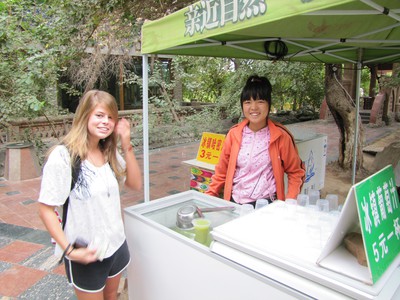


The gang.

Lucy and I had freshly squeezed grape juice. Enormously delicious!


Jiaohe ruins
We visited the ruins of the city Jiaohe, not far outside Turpan. The city was located on a small island where a river splits in two. The island is entirely occupied by a tall cliff with steep sides, providing very good natural defenses. On the top of the cliff, people carved out houses in the (sandstone?) rock. The city was the capital of the "Anterior Jushi Kingdom" from 108 BC to 450 AD. I wish I knew more about who this people were - they do not even have a Wikipedia entry in English. Turpan was the place where (at some point around 1900) remnants of the dead Indoeuropean language Tocharian were found, and it would be interesting to know whether the speakers of Tocharian lived here.
The site was at any rate very interesting. The sandstone is quite eroded, since the city has been abandoned since it was conquered by the Mongols in the thirteenth century.

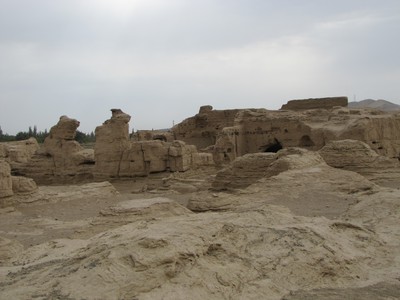

We were allowed to enter down into one of the buildings, which was called "the government office". Miles took the opportunity to sit on the edge and wiggle his feet, to the great amusement of the Chinese visitors to the site.
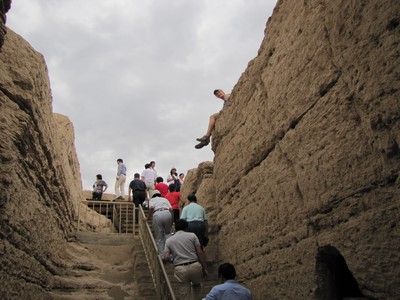
Here is our excellent guide Alem, who took us around both Ürümqi and Turpan.

And finally my daily photo for September 2.
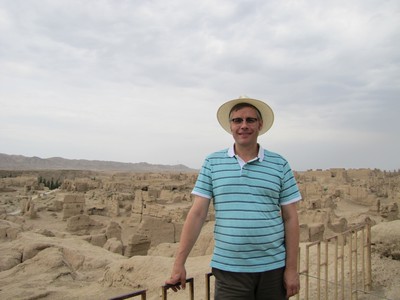
The site was at any rate very interesting. The sandstone is quite eroded, since the city has been abandoned since it was conquered by the Mongols in the thirteenth century.



We were allowed to enter down into one of the buildings, which was called "the government office". Miles took the opportunity to sit on the edge and wiggle his feet, to the great amusement of the Chinese visitors to the site.

Here is our excellent guide Alem, who took us around both Ürümqi and Turpan.

And finally my daily photo for September 2.

Fresh nan in Ürümqi
On our way to dinner our only night in Ürümqi, we found this bakery, where they baked what in Uighur is called "nan" (different from Indian nan). The round ring in the middle of the picture is the oven, shaped like a standing-up barrel. The dough is fastened on the inside of the barrel and is baked there. Several of us bought each a piece of bread. I broke the ice. The students claimed that I got my bread cheaper then they got theirs (probably because I smiled when I asked for it, I argued).
It was absolutely delicious, and so hot that it was hard to hold.

It was absolutely delicious, and so hot that it was hard to hold.

My cute kids on Skype today

Beijing's earliest railway station
We actually intended to go to the Beijing railway museum, which is housed in the city's earliest railway station, which you can see below. Very nice railway architecture from around 1900. Alas, the museum was closed for reparations - something that is all too common in China.


Finally Peking Duck
Today I finally got Peking Duck. It was delicious, of course. We had lunch at one of the city's most famous Peking Duck restaurants. Our meal was also the official welcoming banquet of the Program this semester. Thank you, Ningping and Xiaojie!

Waiting for the duck.
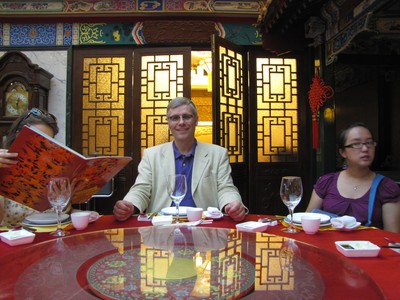

Waiting for the duck.

Urban planning exhibition
Today, September 10, the Yale program organized an excursion to central Beijing. We first looked at the Urban planning exhibition, which is a museum devoted to Beijing. The guided tour and much of the exhibits focused very much on modernity. We got to admire models of various buildings built for the Olympics in 2008, and the tallest buildings, the "Beijing Silicon Valley", and other modernities were especially pointed out to us. Not much about historic preservation. Instead, the guide pointed out that the old small alleys in the hutongs were narrow and crooked. (Indeed, my Baedeker from 1912 warns that they stink and are impossible to get through when it has rained). Of course, the hutongs are being replaced by modern concrete, steel, and glass. According to the Lonely Planet guide to Beijing, 3679 existed in the 1980s, while in 2006 only 430 remained. More will have disappeared since then. Beijing's old buildings are, thus, suffering much of the same fate, and for the same reasons, as the are around St. Clare's church in Stockholm did in the 1960s, altough on a much greater scale. Mao wanted Beijing to become a productive, industrial city, while his successors over the last twenty years are making Beijing into a city of high raises, steel and concrete.
In Stockholm, the government ran out of money before they were able to raze the Old City, which was then something of a slum: unsanitary and not very wholesome. Of course, by now all of it has been carefully renovated through private initiative, and it is among the absolutely most attractive addresses to live in Sweden. It is certainly no longer an unsanitary slum. Perhaps something for Beijinng to learn from?
A great part of the exhibition was a model of the entire city.

But there were signs already at the exhibit that things might be changing in Beijing. For one there was this wonderful model of the Forbidden city.

But perhaps more importantly, there was a newly opened section on historic preservation. Oddly, this was not included in the tour (it looked very new, and there was actually not that much to look at there). At the entrance to this section there was a sequence of busts of the people who drew up the plans for the city in the Yuan, Ming, and Qing periods, and last came Liang Sicheng, who was a professor of architecture at our neighbor, Qinqhua University. He worked on preserving the old architecture of Beijing. The fact that he is given a bust in the Urban planning exhibition suggests that the government has come to share something of his vision, which makes me happy. Unfortunately, they also in Beijing seem to be stuck in the kind of thinking that produces heavy-handed reconstructions (like in Datong) in the style of the much reviled Viollet-le-Duc.

In Stockholm, the government ran out of money before they were able to raze the Old City, which was then something of a slum: unsanitary and not very wholesome. Of course, by now all of it has been carefully renovated through private initiative, and it is among the absolutely most attractive addresses to live in Sweden. It is certainly no longer an unsanitary slum. Perhaps something for Beijinng to learn from?
A great part of the exhibition was a model of the entire city.

But there were signs already at the exhibit that things might be changing in Beijing. For one there was this wonderful model of the Forbidden city.

But perhaps more importantly, there was a newly opened section on historic preservation. Oddly, this was not included in the tour (it looked very new, and there was actually not that much to look at there). At the entrance to this section there was a sequence of busts of the people who drew up the plans for the city in the Yuan, Ming, and Qing periods, and last came Liang Sicheng, who was a professor of architecture at our neighbor, Qinqhua University. He worked on preserving the old architecture of Beijing. The fact that he is given a bust in the Urban planning exhibition suggests that the government has come to share something of his vision, which makes me happy. Unfortunately, they also in Beijing seem to be stuck in the kind of thinking that produces heavy-handed reconstructions (like in Datong) in the style of the much reviled Viollet-le-Duc.

Arriving in Ürümqi
Eight students, two administrators, and I went on this fantastic trip to see Xinjiang, the part of China furthest to the west. It is strictly speaking not a province but an autonomous region. The majority of the population is not Chinese but Uighur, although the government has very much encouraged Han Chinese to move to Xinjiang, so that in the regional capital Ürümqi, half of the population is now Han Chinese. As I understand, the two populations are geographically segregated. Last year there were ethnically motivated riots, about which very little is known since no westerners were allowed into Xinjiang at the time and Chinese media toe the official line.
We had a wonderful time in Xinjiang, where we visited three cities: Ürümqi, Turpan, and Kashgar. The two last are oases in the Taklamakan desert, and Kashgar is in the very west of China.
Here are the students after arrival, waiting for our checked-in luggage.

Russians and people from other former Soviet republics often come to Ürümqi. The airport has flights from these places, and there is a railroad to Kazakhstan, which conveys a lot of trade between China and the former Soviet Union. I believe there must be some tourism as well. At least there are often signs in Russian. I particularly liked this sign at the airport with the same text in four languages in four different writing systems: Uighur, Chinese, English, Russian. A truly cosmopolitan place, as is appropriate for a place on the Silk road.

Ja, så en bild av mig straxt efter ankomst till Ürümqi.

We had a wonderful time in Xinjiang, where we visited three cities: Ürümqi, Turpan, and Kashgar. The two last are oases in the Taklamakan desert, and Kashgar is in the very west of China.
Here are the students after arrival, waiting for our checked-in luggage.

Russians and people from other former Soviet republics often come to Ürümqi. The airport has flights from these places, and there is a railroad to Kazakhstan, which conveys a lot of trade between China and the former Soviet Union. I believe there must be some tourism as well. At least there are often signs in Russian. I particularly liked this sign at the airport with the same text in four languages in four different writing systems: Uighur, Chinese, English, Russian. A truly cosmopolitan place, as is appropriate for a place on the Silk road.

Ja, så en bild av mig straxt efter ankomst till Ürümqi.

My rug from Ürümqi
I bought a small rug at the bazar in Ürümqi. There was a very sweet saleswoman who made a great, but understated show off being shocked at the meagre price I offered for the rug. Of course, I paid far too much for it, but I really like it. It is woven of silk thread. The saleswoman assured me that it was handmade, which is hard to believe, except that I think I actually see some irregularities on its back. Of course, those could have been made on purpose. The main thing is that I like it. It is incredibly soft. I have it next to my bed, and it will work very well in my bedroom in New Haven.


Voting and "Journey to the West"
Today I took my passport and the subway to the Swedish Embassy on the other side of town. I voted in the Swedish parliamentary elections. It was all very fast and relaxed, and I spoke to a nice Swedish woman who took my vote, putting it in an envelope for its onward journey to Stockholm.
Since I anyway was in the embassy and expatriote section of Beijing, I walked over to a shopping centre called Lufthansa, which had been recommended me. They had the usual selection of expensive western stuff, jackets from Hugo Boss and so forth. So I did not buy much, but I found a nice bookstore with foreign books hidden in a corner of the fourth floor. There I bought a set of our volumes of the famous Chinese novel Journey to the West from the sixteenth century. I have had to return the Dream of Red Mansions to the Program library since the semester now has started and students need to have access to the books.
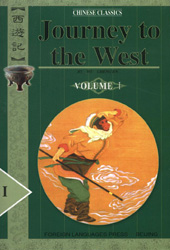
The translation was published by the Foreign Languages Press in Beijing and the four volumes cost only 95 Yuan. The picture is from their website.
Alas, my cold seems to have restarted today. I hope to get better for tomorrow's excursion to two Beijing museums.
Since I anyway was in the embassy and expatriote section of Beijing, I walked over to a shopping centre called Lufthansa, which had been recommended me. They had the usual selection of expensive western stuff, jackets from Hugo Boss and so forth. So I did not buy much, but I found a nice bookstore with foreign books hidden in a corner of the fourth floor. There I bought a set of our volumes of the famous Chinese novel Journey to the West from the sixteenth century. I have had to return the Dream of Red Mansions to the Program library since the semester now has started and students need to have access to the books.

The translation was published by the Foreign Languages Press in Beijing and the four volumes cost only 95 Yuan. The picture is from their website.
Alas, my cold seems to have restarted today. I hope to get better for tomorrow's excursion to two Beijing museums.
Teaching in Bejing
Today I have taught for the first time ever in Beijing. I thought it went well. I had aimed at working on getting both American and Chinese students to talk (since this is a seminar), and I thought it was reasonably successful. There were about 30 students in the classroom. One of them seemed to be Swedish (with a kth.se-address), but I did not realize this until I looked at the sign-up sheet afterwards. 27 applied to take the seminar, so I had to cut five of them (two more cut themselves by forgetting to give their name on the applications). In everything my wonderful assistant Qianyu was of very great help.


Lake Karakul
One of the absolute highlights on our trip to Xinjiang was the visit to Karakul Lake. This gorgeous little lake is situated at an altitude of 3600 meters. The altitude was certainly noticeable! I quickly became short of breath.
Something that makes the lake particularly beautiful is the mountain Muztagh Ata (7546 meters above sea level) that is often reflected by the surface of the lake. Sven Hedin tried to climb this mountain in 1894, but he failed.
A small group of Kirghiz people tried to sell handicraft and offered rides on camels and horses.
I liked the description of the lake on German Wikipedia: "berühmt für seine surreale Szenerie, welche sich mit großer Klarheit im Seewasser spiegelt, das von Dunkelgrün bis Azur- und Hellblau die verschiedensten Färbungen annimmt."
(As always in minority areas of China, it is hard to know how to spell names. I believe Karakul is Kirghiz, which is appropriate, for the population in the immediate neighborhood is Kirghiz. In Uighur, it is something like Karakolum, while it is different in Chinese: 喀拉库勒湖 Kalakule hu. Of course "Lake" is, strictly speaking, unnecessary, like "hu" in Chinese, since "kul" in Kirghiz means "lake". "Kara" means "black").
I am riding camel towards Mustagh Ata


Nichole and Cynthia riding.
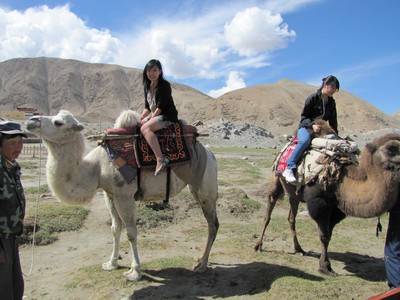
Lucy accompanied by a Kirghiz horse minder (what are his motives?).
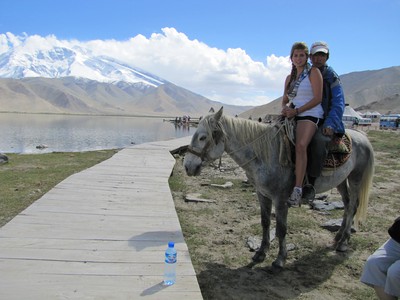
Liz on a horse.
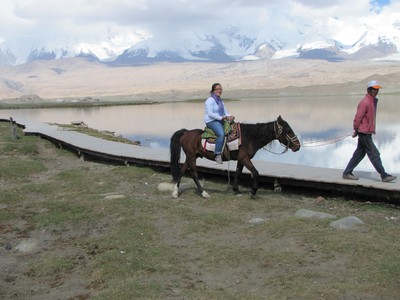
Adam and his horse.
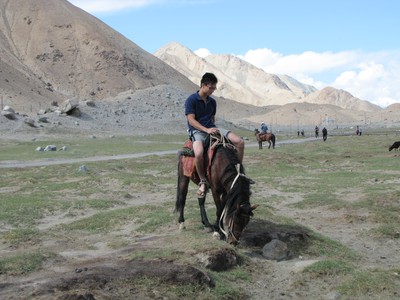
Joanna has ridden camels before and managed hers admirably on her own.

And so did Cynthia.

Miles looks like he wants to conquer Muztagh Ata next.

And finally, Muztagh Ata in all her glory. She is attended by a series of lower peaks. All photographed from a place that is about a mile higher above sea level than the tallest point in Sweden.
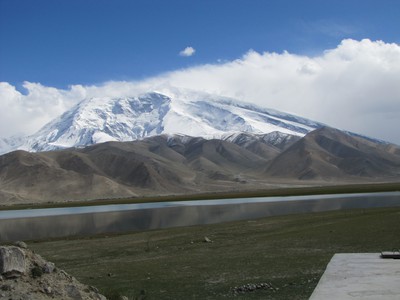
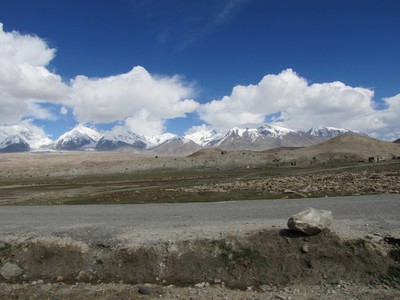
And as a PS, the old outhouse. Here one really needs to know something about non-European scripts to know which side one should choose. I dedicate this picture to the memory of my junior high school Swedish teacher, the brilliant Nils G Hörnström, who once said that one of his favorite visual jokes was an old cartoon of a man in obvious need staring confusedly at two doors with only texts in incomprehensible languages. He used this as an argument for learning foreign languages. In the thirty years since I heard this from him, I had never seen any such doors, until I got to Lake Karakul. (Hint: men go to the left.)

Something that makes the lake particularly beautiful is the mountain Muztagh Ata (7546 meters above sea level) that is often reflected by the surface of the lake. Sven Hedin tried to climb this mountain in 1894, but he failed.
A small group of Kirghiz people tried to sell handicraft and offered rides on camels and horses.
I liked the description of the lake on German Wikipedia: "berühmt für seine surreale Szenerie, welche sich mit großer Klarheit im Seewasser spiegelt, das von Dunkelgrün bis Azur- und Hellblau die verschiedensten Färbungen annimmt."
(As always in minority areas of China, it is hard to know how to spell names. I believe Karakul is Kirghiz, which is appropriate, for the population in the immediate neighborhood is Kirghiz. In Uighur, it is something like Karakolum, while it is different in Chinese: 喀拉库勒湖 Kalakule hu. Of course "Lake" is, strictly speaking, unnecessary, like "hu" in Chinese, since "kul" in Kirghiz means "lake". "Kara" means "black").
I am riding camel towards Mustagh Ata


Nichole and Cynthia riding.

Lucy accompanied by a Kirghiz horse minder (what are his motives?).

Liz on a horse.

Adam and his horse.

Joanna has ridden camels before and managed hers admirably on her own.

And so did Cynthia.

Miles looks like he wants to conquer Muztagh Ata next.

And finally, Muztagh Ata in all her glory. She is attended by a series of lower peaks. All photographed from a place that is about a mile higher above sea level than the tallest point in Sweden.


And as a PS, the old outhouse. Here one really needs to know something about non-European scripts to know which side one should choose. I dedicate this picture to the memory of my junior high school Swedish teacher, the brilliant Nils G Hörnström, who once said that one of his favorite visual jokes was an old cartoon of a man in obvious need staring confusedly at two doors with only texts in incomprehensible languages. He used this as an argument for learning foreign languages. In the thirty years since I heard this from him, I had never seen any such doors, until I got to Lake Karakul. (Hint: men go to the left.)

At home in Beijing
I came home to my apartment just before 2 a.m. It is nice to be back after a wonderful trip. Tuesday, I slept late and then went in to my office. I had a very good meeting with my second teaching assistant. Then we had a Master's Tea with Gu Xiaocheng, who is a retired professor at Peking University. She became a student at the university in 1948, when the Guomintang still held Beijing but lived earlier in Japanese-occupied Tianjin. So she has lived through some of the most interesting events in modern Chinese history: Japanese occupation, civil war, the Communist takeover, the Cultural Revolution, and the Opening of China to the West. She had many interesting stories to tell, and she told them in near-perfect English and with great charisma.
So here I am in my office just before the talk.
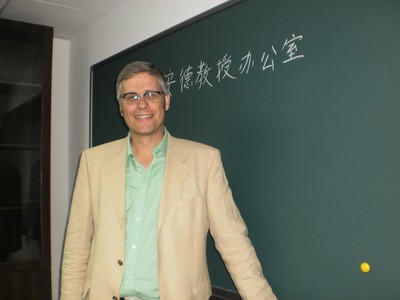
And here is the building in which our offices are.
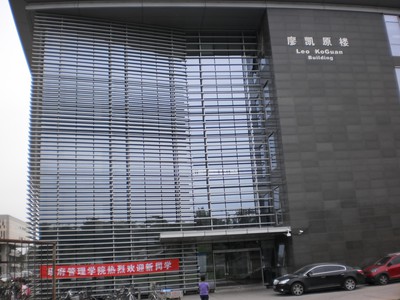
So here I am in my office just before the talk.

And here is the building in which our offices are.

Riding camel at Lake Karakolum
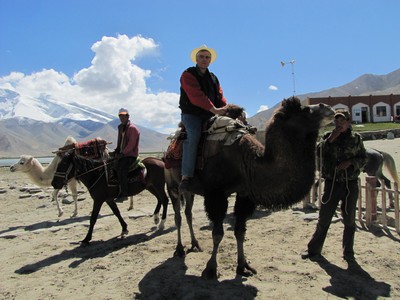
On our way to Beijing
The sand clouds have lightened, and the entire group has now checked in for a flight to Urumqi, from where we have a reservation today to Beijing. If everything works out fine, we should be able to get home today, although it might be past midnight. Ningping has done a wonderful job of rebooking us onto different flights.
Sandstorm in Kashgar
Today while we were at the livestock market of Kashgar, it seemed that fog was descending upon us. This turned out to be a dust cloud, very unusual this time of year in Kashgar. After a while, we all started to cough, since we breathed in the dust. Our very able guide Muhammed organized mouth protectors for all of us, which made it easier to breathe. We continued our program as planned, visiting the great mausoleum (which includes the mosque at which The Kiterunner was filmed), the Great Bazaar (where I haggled in uighur, which our guide had taught those of us who wanted on the very long bus ride the day before), the Great Mosque (where I for the first time in my life had the experience of removing my shoes to enter a mosque). Well, we had our usual day, fully loaded with exciting program points; we were just a little inconvenienced by all the dust. But of course, no airplanes can fly in sandstorms, so what we feared turned out to be reality: our evening flight to Urumqi was cancelled (we were supposed to stay overnight there and then continue tomorrow to Beijing). So our guide and Yale's administrators got on their cell phones and booked us for another night in the same charming hotel that we stayed at for the last two nights. Right now, Ningping is at the airline office to see if they think they can get us to Urumqi tomorrow morning instead so that we may continue to Beijing as originally planned. We'll see. We are not suffering meanwhile.
I made my way to a Chinese internet cafe. One hour of internet costs 2 RMB (2.20 SEK, 30 cents). The room is full of young people, most of whom are playing games (and smoking, as is done very much in this country). I was not supposed to be able to use the internet without showing my passport, but Ningping has that with her to the airline office. I showed them my Yale ID, and that seemed to work. Of course, I cannot upload any pictures here. I have really many pictures, which it will take me time to catch up with. We have had a wonderful trip, seen so many amazing sights. Yesterday, I rode a camel at the altitude of 3600 meters above sea level (which I suppose to equal about 10,000 feet) at the shores of a lake that reflected the snow-clad peak of X, some 7600 meters tall, in the Karakorum mountain range. (I will have to fill in the details when I can look them up.) I was wondering why I became short of breath without any real provocation, until I realized that it was the thin air at the altitude.
Stay tuned for more details and pictures when I am back in Beijing (whenever we get back; sandclouds do not necessarily settle very quickly, but they are optimistic that we might be able to fly out tomorrow morning).
I made my way to a Chinese internet cafe. One hour of internet costs 2 RMB (2.20 SEK, 30 cents). The room is full of young people, most of whom are playing games (and smoking, as is done very much in this country). I was not supposed to be able to use the internet without showing my passport, but Ningping has that with her to the airline office. I showed them my Yale ID, and that seemed to work. Of course, I cannot upload any pictures here. I have really many pictures, which it will take me time to catch up with. We have had a wonderful trip, seen so many amazing sights. Yesterday, I rode a camel at the altitude of 3600 meters above sea level (which I suppose to equal about 10,000 feet) at the shores of a lake that reflected the snow-clad peak of X, some 7600 meters tall, in the Karakorum mountain range. (I will have to fill in the details when I can look them up.) I was wondering why I became short of breath without any real provocation, until I realized that it was the thin air at the altitude.
Stay tuned for more details and pictures when I am back in Beijing (whenever we get back; sandclouds do not necessarily settle very quickly, but they are optimistic that we might be able to fly out tomorrow morning).
Xinjiang
We are having a wonderful time in Xinjiang, seeing all kinds of very interesting things. We have been up in the mountains to enjoy the Heavenly Lake where temperatures were even on the cool side, we have driven through the Gobi dessert and today we are in the old oasis Turpan (where the Silk Road passed through).
Here is a Jag idag-bild from Heavenly Lake on Thursday.
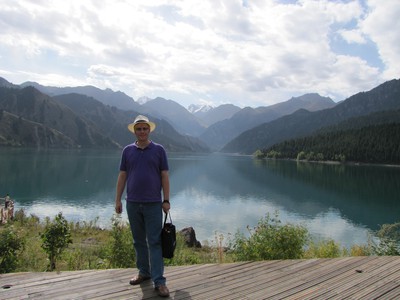
Here is a Jag idag-bild from Heavenly Lake on Thursday.

